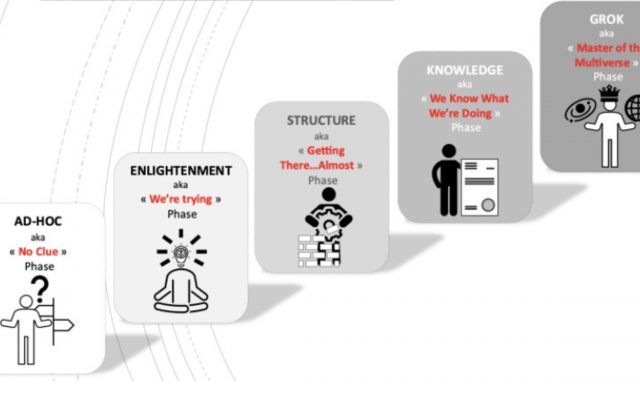Why it actually takes 5 minutes to determine the Data Maturity of an organization and why it is useful for this organization to know its data maturity level.
First of all, let’s clarify what data maturity is. When searching the web for a definition, one can find different types of results. Most will focus on the maturity related to a specific data topic such as data analytics, data management, data governance, big data analytics, etc. In the context of data strategy, I prefer using a much broader view of data maturity by focusing on all the activities enabling management and usage of data assets. It is how much knowledgeable this organization is on data topics that we try to assess. Not only that, it is the ability of an organization to manage efficiently its data assets that will determine its level of data maturity. So, to assess data maturity, one needs to look at how an organization addresses topics such as strategy, value creation, roles, governance, architecture, culture, etc. All these topics constitute an ecosystem which supports the organization in the management and valorization of its data assets.
As a definition, I would therefore propose the following:
Data maturity measures the proficiency of an organization to efficiently manage its data assets and leverage their value.
Before delving into Data maturity, we should clarify something else: What is a data asset? Over the past few years, the term “Data Asset” has been extensively used to highlight the importance of data. Having studied economics and finance, I’m used to the financial accounting view of assets defined by Wikipedia as being “any resource owned or controlled by a business or an economic entity. It is anything (tangible or intangible) that can be utilized to produce value and that is held by an economic entity and that could produce positive economic value”. What I find very interesting in this definition are the concepts of ownership and value. Why? Because they are fully applicable to data. Data assets are owned by organizations and have a value for them.
So, acknowledging that data is an asset would seem only normal for any organization. Even more so in our digital era. But it’s not always the case. Not all organizations have understood the value of data, although to be fair, this number is shrinking drastically. Not all organizations are ready to consider data as an asset. And yet, it is critical for an organization willing to increase its data maturity. But it comes at a price. It implies that data should be managed similarly to a financial asset and we will see in upcoming episodes of the Data Strategy Made Simple series that it requires the set-up of a specific data ecosystem and a specific approach to manage these assets.
To define the concept of “Data Assets”, we need to understand what they can be. And that’s where it gets tricky. Data assets come in different shapes and forms. From a legal standpoint, a data asset relates to any software or electronic data that exists in IT systems. In our digital world, it basically means that all the information an organization is producing and handling digitally can be considered a data asset. Whether raw (i.e. directly from the data source), transformed (i.e. cleaned and processed) or edited (i.e. for reporting and analytical purposes), data assets can be found in domains such as customer relationship management, financial and accounting, transactions, human resources, corporate procurement, supply chain, operational activities, IT production systems, commercial and marketing, risk management, audit, facilities, etc. Data assets can either be an internal element of the organization or acquired from an external third party. The many dimensions of data assets constitute an almost endless universe of possibilities.
What truly matters is the value data assets can bring to the organization. This statement is actually crucial in the understanding of the nature of data assets. Contrarily to gold or money, the value of data assets is not only determined by their face value or market value. Monetized data assets (e.g. data sold for a monetary value) are subject to the demand/ supply market rules. For non-monetized data assets, their value is dependent upon the ability of an organization to use it efficiently and for the right purpose.
This ability is materialized by products (e.g. raw data, transformed data, reports, analytics, data science, artificial intelligence) and monetization (i.e. selling data products). Data collected and created for monetization purposes has a market value as there is someone willing to purchase it. Social media and marketers confirm that on a daily basis. But most data assets have limited to no value. Take the example of a transaction time stamp in a financial company. As such, its value is 0. What’s the point in knowing that a specific transaction took place on 25/02/2021 – 09:25:54? But used in the context of an analysis aimed at predicting similar future transactions, this time stamp becomes valuable in that it helps describing the transaction it is linked to and enables categorization and comparison with other transactions.
So, as for a definition, I would suggest that:
A data asset is any data owned by an organization which, when exploited adequately and efficiently, can generate value for the organization.
Having clarified (I hope) what is a data asset, let’s go back to Data Maturity and explain why it takes only 5 minutes to determine it. Actually, it takes 5 minutes if one talks with the right person(s), asks the right questions, carefully listens, has a broad knowledge of market practices and is sufficiently experienced with data matters. It might look like I’m adding up a complete set of criteria to condition the feasibility of this 5-minutes assessment. But in reality, it’s only about looking for some keywords and contextual information which will help identifying which level of maturity characterizes the organization. To do so, a simple set of 6 questions to be asked to the right person should be sufficient. By the way, when reading “the right person”, one should understand someone in the organization who has knowledge of data initiatives and issues. A certain level of involvement of this person in data matters is required to ensure the validity of the answers.
Before going any further, although it might take 5 minutes to make a first assessment of where an organization is in its data maturity, it doesn’t mean a more thorough assessment isn’t required. As I will detail in a coming episode of this Data Strategy Made Simple series, a data strategy is composed of several dimensions and requires the set-up of a specific data ecosystem. Assessing the data maturity of an organization requires to understand how this organization addresses all these dimensions and which data ecosystem is in place. That’s why data consultants prefer not to rely only on a 5 minutes assessment and rather use surveys, interviews and specific tools to assess the data maturity of an organization in details. It’s not about charging our clients for something we already know. It’s about identifying all the weaknesses and coming up with a comprehensive set of recommendations to help increase the data maturity.
So, which questions should you ask:
- Do you know if there is any data strategy in place and if yes, how would you summarize it?
- Is there a person or business unit(s) in charge of data matters in your organization?
- Which IT tools and solutions are available to manage and use data?
- What are the data use cases that create the most value?
- What would you describe as being the main data challenges?
- On a scale of 1 to 5, 1 being zero maturity, how would you score your organization?
The point here is not to ask all these questions in 5 minutes. In most cases, question 1 on data strategy will be enough. If there is a data strategy and it can be summarized, it is already an indication that the organization is not in an early stage of data maturity. Organizations with a data strategies have acknowledged and understood that data is an asset and are setting up an ecosystem that will support the management and usage of data. How advanced is this strategy and how well it is designed to efficiently support the realization of corporate objectives are other questions that will help refine the data maturity assessment. (Cf. Data Strategy Made Simple – Episode 1 for the definition of data strategy)
If there is no formal data strategy but the organization has set-up dedicated data roles and responsibilities, specific data processes and principles, technologies to support data management and consumption, and can demonstrate a certain proficiency on data topics, then this organization is also not in an early stage of data maturity. The information we are looking for is whether or not the organization has already started structuring the way it addresses data challenges. If it is the case, we know that the organization is already mid-way on its data maturity.
Asking the question about data strategy and listening carefully to what your interlocutor will provide as explanations allows to make a first assessment. Words or expressions such as “no coordination”, “lack of clear responsibilities”, “we’re trying but…”, “we don’t have the right tools”, “poor data quality”, will confirm that the organization is either in early stages of data maturity or blocked mid-way.
By now, you should be asking yourselves what are the stages of data maturity. To answer this question, I’ve designed a Data Maturity Model composed of 5 stages . According to me, these 5 stages are self-explanatory and are a coherent representation of the current market practices. One thing to be carefully considered is the fact that data maturity shouldn’t be some sort of competition. Whether in an early stage or an advanced stage, the data maturity of an organization should not be viewed as some sort of judgement on its performance. Each organization has its own reality, its own challenges which explain their level of data maturity. That is why one should never advise to systematically reach the highest level of data maturity, as this level might not be what is adequate for the organization. The various stages of maturity are there to provide guidance and direction, to support an organization in increasing its data maturity in response to its own challenges, requirements and corporate objectives. In other words, when someone claims that all companies should be “data driven” (which is usually the words used to describe the highest level of data maturity in many models), ask that person why. Ask that person how this level of maturity will help your organization in handling your challenges, requirements and corporate objectives. Ask that person whether it is achievable and in which timeframe. In most cases, it will not be necessary to reach this level to address the reality of your needs.
So, what are those 5 stages. Here are my two cents:
AD-HOC aka « No Clue » Stage
– Data is used for reporting and analysis for ad-hoc purposes but there is no clear understanding of its importance, how to leverage its value and what it can bring to the organization.
ENLIGHTENMENT aka « We’re trying »Stage
– The company has realized that data is important and requires a specific focus. Uncoordinated initiatives pop-up, roles are created, technology investments are made but data expertise is low and there is no formal strategy or coordination in place.
STRUCTURE aka « Getting There…Almost » Stage
– The data ecosystem is under construction: strategy, organization, governance, architecture, culture, analytics and reporting are all addressed in a somewhat coordinated way with the aim of enabling the company to effectively leverage the value of data. Data is considered as a strategic asset but not yet fully managed and valued as such.
KNOWLEDGE aka « We Know What We’re Doing » Stage
– All aspects of the data ecosystem are prioritized, coordinated and managed to ensure the efficiency of the data strategy. Inefficient data processes, data quality issues and incidents on data applications are systematically addressed. Knowledge and understanding of data topics are spread across the company and ensure an efficient use of data creating added value and supporting the realization of corporate objectives.
GROK aka « Master of the Multiverse »Stage
– The data strategy is effectively supporting the corporate objectives through a comprehensive and efficient data ecosystem embedded in the company’s culture, organization and processes. All data topics are mastered by the company in such a way that they have now become commodities. Data is not a concern anymore; it is a value-based tool supporting both the strategic and operational decision-making process at all levels of the company, fully integrated in the business processes and working habits.
If you want to remember these 5 stages easily, I came up with a simple sentence using the first letters of each stage: “An Enlightened organization Structures its Knowledge to master and Grok data”. It’s not 100% correct and it might not be the best sentence ever, but it helps remembering it.
In this episode, I’ve tried to present some of the key elements to understand when it comes to Data Maturity. Yes, it is possible to assess the data maturity of an organization in 5 minutes. But it won’t be sufficient to help this organization in identifying its challenges and provide added value recommendations. So, one advice: when assessing the data maturity level of your organization, always ask yourself what is the target data maturity level that suits your specific data needs.
In summary:
1. Data maturity measures the proficiency of an organization to efficiently manage its data assets and leverage their value.
2. A data asset is any data owned by an organization which, when exploited adequately and efficiently, can generate value for the organization.
3. It is possible to make a 5 minutes data maturity assessment if one talks with the right person(s), asks the right questions, carefully listens, has a broad knowledge of market practices and is sufficiently experienced with data matters.
4. Although it might take 5 minutes to make a first assessment of where an organization is in its data maturity, a more thorough assessment is required to identify weaknesses, propose added value recommendations and design an efficient action plan
5. A simple 5-stages Data Maturity Model can be used. The 5 stages are: ad-hoc, enlightenment, structure, knowledge, grok
6. When assessing the data maturity level of your organization, always ask yourself what is the target data maturity level that suits your specific data needs.
The next episode in the Data Strategy Made simple series will give an overview of the dimensions of data strategy.
And if you figured out why I’ve named the last stage GROK aka “Master of the Multiverse” stage, please leave a comment or send me a DM. I’m curious to know how you interpret it.
Article by channel:
Everything you need to know about Digital Transformation
The best articles, news and events direct to your inbox
Read more articles tagged:









